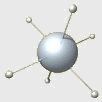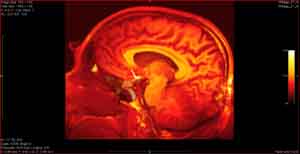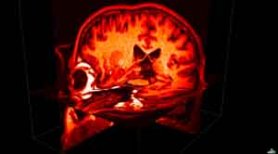
blogging
minding houses: thomas markussen + thomas birch
download pdf
 |
intelligent agent vol. 5 no. 2
blogging minding houses: thomas markussen + thomas birch download pdf |
|
Minding Houses
Thomas Markussen & Thomas Birch, aka bleep.dk |
|||||||||
| |||||||||
By 2004, the Arsenale was completely full of digital work -- there was nothing there that was not digital, except mine, which was bio and which was placed in the position of honor," comments Novak with a smile. "It was really recognized as the next step, and it's surprising how fast publications are popping up everywhere with biologically derived forms and buildings. The Neuro will come after that. And I think this event is going to resonate in its own way, with neuroarchitecture to follow. The "AlloBio" notion is derived from Greek and describes an alien architecture crossing the line between the living and the dead. Until now, so-called intelligent buildings' reactions to human behaviour were determined by the integration of enormous amounts of electronic installations and computers within the buildings. But the walls and body of the AlloBio building are alive and sensitive, in a fundamentally different manner, not unlike human skin. The organic surfaces within the buildings or creatures are covered by hair-thin optical-fibre sensors, and are able to react to fluctuations in the given parameters, such as changes in pressure or temperature, by contracting or enlarging themselves. This architecture is comparable to a biosphere that grows and develops concurrent with its inhabitants and other outside influences. But in contrast to a plant, it also has a quick-acting nervous system with animal-like reflexes, enabling it to react instantly to threats, such as earthquakes. This living, breathing house is developed in close cooperation with molecular biologists at the California Nanosystems Institute. I have collaborated with molecular biologists where we have designed architectural things at nano-scale really, with RNA. It's almost a necessity. I mean that's where everything is going, so the AlloBio building was an exploration of the 'premise' that we are going to make buildings 'grow.' The result is not to be taken literally; it may take us a long time to actually make a growing building. It's really more of a theoretical proposition that eventually will be carried out when the right moment comes. It is obvious from Novak's firm manner during this intense interview that he's perfectly serious about all of this. In nano-technology he sees a real possibility for architects to influence the properties of architectural materials -- within the atomic building blocks of the world. These can be very heterogeneous properties, such as organic versus inorganic, which nonetheless -- through manipulations on a nano-level -- can be combined into the same Allo-biological material:  
Novak's inspiration was unmistakably felt when two odd houses were built on the artificially constructed island Neeltje Jans by the Rotterdam / Holland based drawing offices NOX and Kaas Oosterhuis' ONL Office in 1997 -- an event that has since been ascribed epoch-making influence in architecture worldwide. H20eXPO, the saltwater pavilion by NOX, was especially sensational. From a distance, the 65 meter-long building appears to be a very long and deformed sea snake built out of curved, high-gloss steel. This remarkable exterior is mirrored in the interior by a revolutionary new form of 3-dimensionality. Instead of a traditional box-formed room, with easily graspable geometrical forms, one surprisingly falls into a dynamically changing space with no concrete points of orientation. The Hullabaloo House of the computer age that, its widespread entertainment value aside, did not only have a humorous purpose, but was intended to illustrate that spatiality, the human body and human consciousness were capable of interacting with each other in an equal and dynamically developing relationship -- a house in a constant process of ongoing self-renewal, and dialogue with its visitors. The interior of the H20eXPO had been modelled on observations and analyses of hidden patterns lying behind people's motions in different types of rooms. The result of this process is a space where walls and floors melt together and new hybrid forms of room and furniture-like structures arise, and float or merge indifferently in and out of each other. With the H20eXPO, NOX have created a so-called motorical room that, thanks to animation software, has been realized not merely as a computer model but as an actual building -- a room that simply removes the classical architectural distinction between walls and floors, and between function and form. A "bluish" atmosphere of constantly changing form and structure is created inside the room. Consisting of enormous banks of sensor-controlled lamps, it interacts with the behaviour and movement of the visitors. The room synchronizes itself in real-time to movements of the body and, as it were, answers and reacts to the brain impulses carried out by the body. This building was the crystallization of Novak's predictions concerning neuro-architecture as (a) liquid architecture -- one of his earlier visions that specifically combined the constellation of plastic architecture and new technology, gaining him design-guru status amongst the next generation of architects. In short, liquid architecture has set the agenda for architecture at the beginning of the 21st century.
Some of the conclusions that we apparently are heading towards at the moment could involve the perspective of liquid architecture, in that we conceptually cannot understand or comprehend the human brain without it. The brain clearly has a certain determining form, but one that changes over time. We can see that some of the ways in which he has been thinking about form and structure are simply epoch-making in relation to our work, and can provide us with a language which, on the one han,d is ground-breaking and, on the other, can assist us in understanding how these brain processes unfold. And it is incredible that his computer models of these processes can help formulate a new language. Novak's lifelong project of renewing architecture goes back to when, as a young student of architecture, he discovered that something fundamental was missing in the architecture of his own time: "I think it all started when I experienced a deep division between architecture and the world that it was supposed to be a part of. Admittedly architecture had renewed itself through the 70s and 80s, but in a very unfortunate way, that simply did not work." Novak revitalized architecture by reuniting it with developments in, and the application of, new technologies. This began with his involvement in computer science in the late 70s, when he was the only architect among the programmers in the Computer Science Department at the University of Ohio. These were absolute groundbreaking years in the history of information technology-based architecture. But since then, computer science has been augmented by nanotechnology, molecular biology and neuroscience as integral design tools. For Novak, these are essential and necessary tools for architects. It is not at all unlikely that in a couple of years' time we will see students at schools of architecture worldwide designing their own particles. Nanotechnology and the new materials that this technology enables already heavily influence the world around us. Architecture must follow the times. For architecture, therefore, the point is to be constantly abreast of culture's development, moving and reacting at the same pace, instead of waiting 20, 30 or 80 years. Translation by Phillip Shiels and Thomas Birch References
|